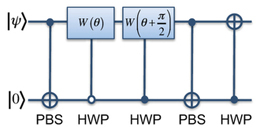Research Abstract
ハイゼンベルクの誤差–擾乱の不確定性関係の破れと再定式化の実験
Experimental violation and reformulation of the Heisenberg's error-disturbance uncertainty relation
2013年7月17日 Scientific Reports 3 : 2221 doi: 10.1038/srep02221

1927年にハイゼンベルクによって定式化された不確定性原理は、1つのオブザーバブルの測定誤差と、もう1つの相補的なオブザーバブルに生じる擾乱の間には、この2つの積がプランク常数で決まる下限よりも小さくならないというトレードオフ関係があることを記述している。しかし、1988年に小澤は、ハイゼンベルクの不確定性関係を破る位置測定のモデルを示し、2003年に誤差と擾乱に関するもう1つの関係式(小澤の不等式)が普遍的に成立することを示した。今回我々は、射影測定より一般的な種類の量子測定を利用して、単一光子偏光キュービットで小澤の不等式を実験的に検証した結果を報告する。この検証は、線形光学デバイスによって実行され、今回の実験パラメーターの全範囲でハイゼンベルクの関係式を破るが、それでも小澤の不等式は有効である間接測定モデルを実現している
So-Young Baek1*, 金田 文寛1, 小澤 正直2 & 枝松 圭一1
- 東北大学 電気通信研究所
- 名古屋大学大学院 情報科学研究科
*現所属先:デューク大学(米)
The uncertainty principle formulated by Heisenberg in 1927 describes a trade-off between the error of a measurement of one observable and the disturbance caused on another complementary observable such that their product should be no less than the limit set by Planck's constant. However, Ozawa in 1988 showed a model of position measurement that breaks Heisenberg's relation and in 2003 revealed an alternative relation for error and disturbance to be proven universally valid. Here, we report an experimental test of Ozawa's relation for a single-photon polarization qubit, exploiting a more general class of quantum measurements than the class of projective measurements. The test is carried out by linear optical devices and realizes an indirect measurement model that breaks Heisenberg's relation throughout the range of our experimental parameter and yet validates Ozawa's relation.

